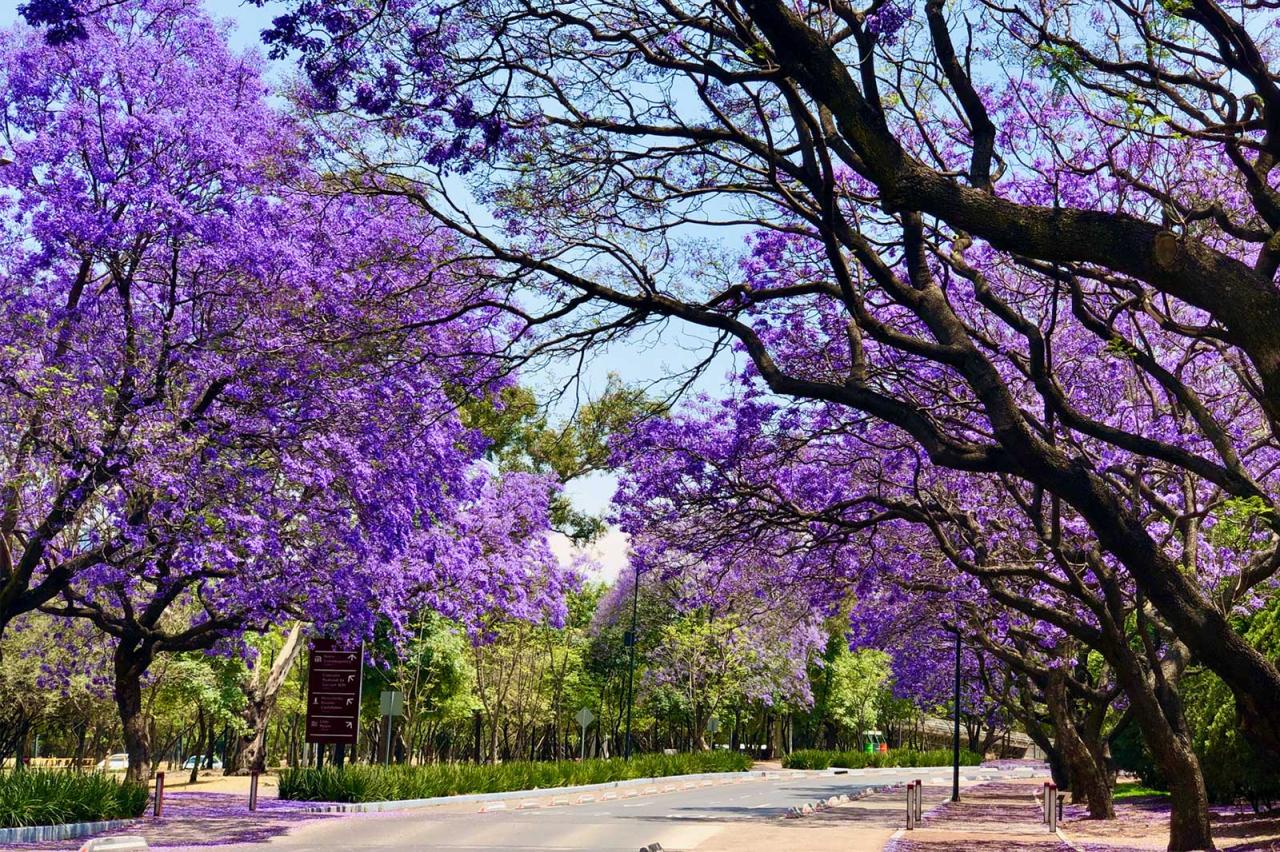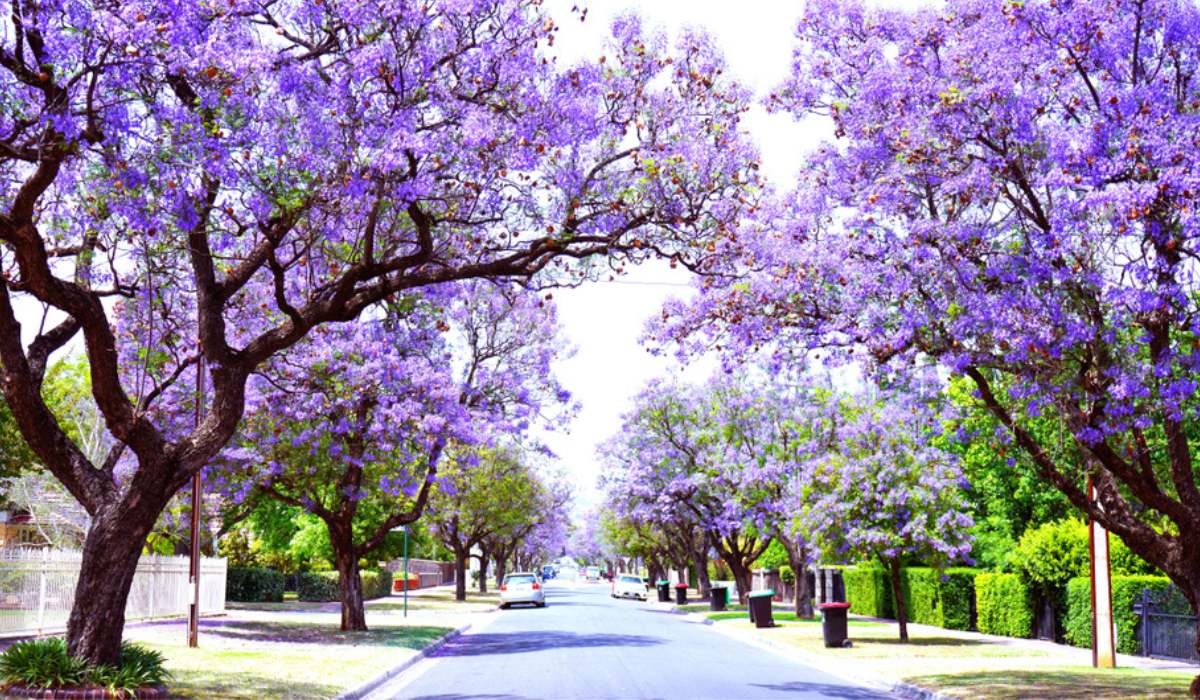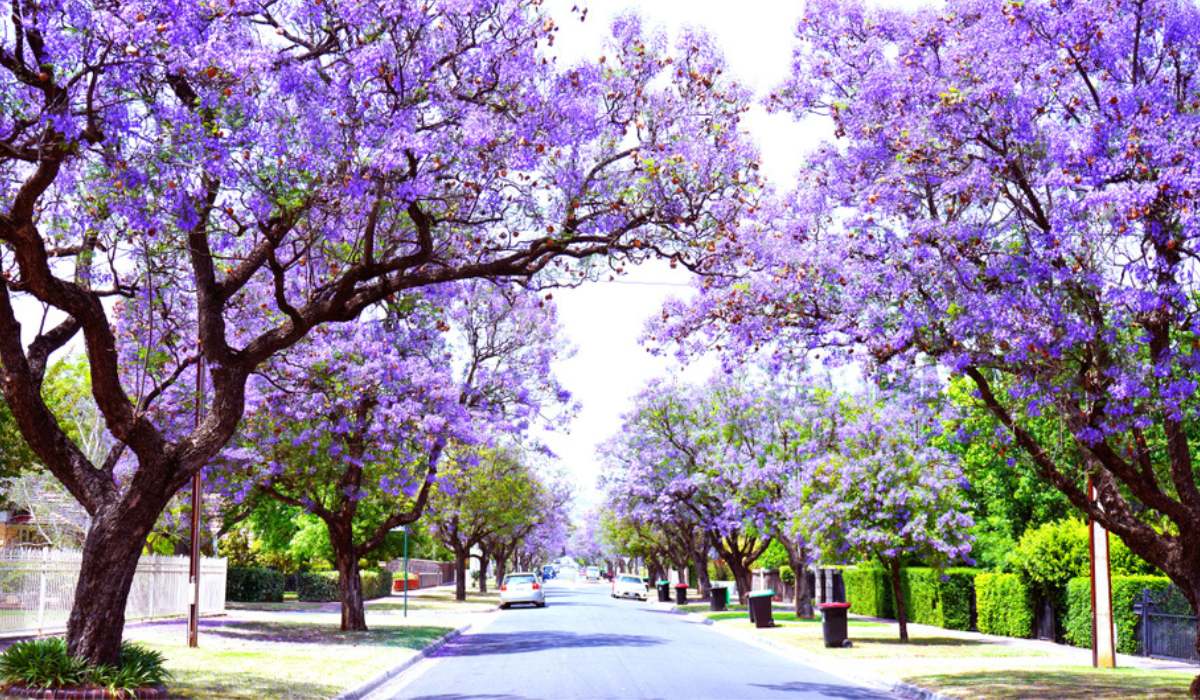How to Achieve Garden Elegance with Jacaranda Tree: Expert Tips for Growing and Maintenance – Imagine a garden awash in a vibrant tapestry of purple, a breathtaking spectacle orchestrated by the majestic Jacaranda tree. This iconic species, with its captivating blooms and graceful form, has long captivated gardeners seeking to infuse their landscapes with a touch of exotic charm.
From selecting the perfect Jacaranda variety to nurturing it through the seasons, this guide provides a comprehensive roadmap for cultivating this horticultural treasure, transforming your garden into a tranquil haven of beauty.
The Jacaranda tree, native to South America, is renowned for its stunning display of lavender-blue flowers that cascade over its branches, creating a breathtaking spectacle that rivals the most vibrant sunsets. Beyond its aesthetic appeal, the Jacaranda holds cultural significance, symbolizing hope, prosperity, and the arrival of spring in many regions.
Its presence in a garden evokes a sense of tranquility and wonder, inviting contemplation and a connection with nature’s artistry.
The Allure of the Jacaranda Tree

The Jacaranda tree, with its captivating beauty and unique characteristics, is a true gem for any garden seeking a touch of elegance. Its vibrant purple blooms, delicate foliage, and graceful form create a mesmerizing spectacle that transforms any landscape into a haven of tranquility and charm.
Cultural Significance and Symbolism
Beyond its aesthetic appeal, the Jacaranda tree holds deep cultural significance and symbolism. In many parts of the world, it is associated with good luck, prosperity, and the arrival of spring. The tree’s vibrant purple blooms are often seen as a symbol of joy, beauty, and new beginnings.
In South Africa, for example, the Jacaranda tree is deeply intertwined with the country’s history and culture, and its blooming season is celebrated with festivals and events.
Enhancing Garden Aesthetics
The Jacaranda tree’s unique characteristics make it an ideal choice for enhancing the aesthetic appeal of any garden. Its cascading canopy of delicate, fern-like foliage provides a sense of privacy and shade, while its vibrant purple blooms create a stunning visual display.
- Creating a Tranquil Atmosphere:The Jacaranda tree’s soft, delicate foliage and vibrant blooms create a sense of tranquility and peace. The gentle rustling of leaves and the soft fragrance of the flowers evoke a sense of serenity and relaxation. Imagine sitting beneath the tree’s shade, surrounded by its vibrant blooms, and feeling the gentle breeze rustling through its leaves.
- Adding a Touch of Color:The Jacaranda tree’s vibrant purple blooms add a splash of color to any garden, transforming it into a vibrant and inviting space. The flowers contrast beautifully with the lush green foliage, creating a stunning visual display that is sure to capture attention.
- Providing Shade:The Jacaranda tree’s dense canopy provides ample shade, creating a cool and inviting space for relaxation and enjoyment. Imagine spending a hot summer afternoon beneath the tree’s shade, enjoying the cool breeze and the vibrant blooms.
Choosing the Right Jacaranda for Your Garden
The Jacaranda genus boasts several species and varieties, each offering a unique blend of size, growth habit, and flowering characteristics. Choosing the right Jacaranda for your garden depends on your specific needs and the environment you’re working with. Understanding the nuances of different varieties will help you select the perfect tree to enhance your garden’s beauty and elegance.
Jacaranda Species and Varieties
Selecting the right Jacaranda variety involves considering factors such as mature size, growth habit, flowering time, and hardiness zones.
Mature Size
Jacaranda trees can range in size from small, multi-stemmed shrubs to towering giants. For smaller gardens, consider varieties like Jacaranda mimosifolia ‘Blue Bell’ or Jacaranda acutifolia ‘Bonsai,’ which remain compact. For larger spaces, Jacaranda mimosifolia ‘Black Magic’ or Jacaranda copaia are excellent choices.
Growth Habit
Jacaranda trees can have a variety of growth habits, ranging from upright and columnar to spreading and weeping. Jacaranda mimosifolia ‘Blue Bell’ and Jacaranda acutifolia ‘Bonsai’ are known for their compact and upright growth, while Jacaranda mimosifolia ‘Black Magic’ and Jacaranda copaia are more spreading and open.
Flowering Time
The flowering time of Jacaranda trees varies depending on the species and variety. Jacaranda mimosifolia ‘Blue Bell’ and Jacaranda acutifolia ‘Bonsai’ bloom in spring, while Jacaranda mimosifolia ‘Black Magic’ and Jacaranda copaia flower in summer.
Hardiness Zones
Jacaranda trees are generally hardy in USDA Hardiness Zones 9-11. However, some varieties are more tolerant of cold temperatures than others. Jacaranda mimosifolia ‘Blue Bell’ and Jacaranda acutifolia ‘Bonsai’ are more cold-tolerant than Jacaranda mimosifolia ‘Black Magic’ and Jacaranda copaia.
Jacaranda Variety Comparison Table
Variety |
Mature Size |
Flower Color |
Bloom Time |
Hardiness Zones |
|---|---|---|---|---|
Jacaranda mimosifolia ‘Blue Bell’ |
20-30 feet tall |
Blue |
Spring |
9-11 |
Jacaranda acutifolia ‘Bonsai’ |
10-15 feet tall |
Blue |
Spring |
9-11 |
Jacaranda mimosifolia ‘Black Magic’ |
40-50 feet tall |
Dark blue |
Summer |
9-11 |
Jacaranda copaia |
60-80 feet tall |
Purple |
Summer |
9-11 |
Planting and Growing Your Jacaranda Tree

Planting a Jacaranda tree is an exciting step towards adding a touch of tropical elegance to your garden. However, successful growth requires careful planning and attention to the tree’s specific needs. This section provides detailed instructions on the planting process, including site selection, soil preparation, and proper planting techniques.
We’ll also discuss the importance of providing adequate sunlight, water, and drainage for healthy growth, as well as tips for protecting your young Jacaranda tree from pests, diseases, and extreme weather conditions.
Site Selection and Soil Preparation
The first step in planting your Jacaranda tree is selecting the right location. Jacaranda trees thrive in warm, sunny climates and require well-drained soil. Choose a spot that receives at least six hours of direct sunlight daily. Avoid planting near buildings or structures that could impede the tree’s growth or cause root damage.Once you’ve chosen a suitable location, prepare the soil by loosening it to a depth of at least 18 inches.
This allows for proper root development and drainage. If your soil is compacted or poorly draining, you may need to amend it with compost or other organic matter.
Planting Techniques
When planting your Jacaranda tree, follow these steps:
- Dig a hole that is twice as wide and as deep as the root ball of the tree.
- Carefully remove the tree from its container, being mindful of the delicate roots.
- Place the tree in the hole, ensuring that the top of the root ball is level with the surrounding ground.
- Backfill the hole with the prepared soil, gently tamping it down around the roots.
- Water the tree thoroughly to settle the soil and encourage root growth.
Sunlight, Water, and Drainage
Jacaranda trees need ample sunlight to thrive. They should receive at least six hours of direct sunlight per day. In areas with cooler climates, they may need a slightly more sheltered location.Water your Jacaranda tree regularly, especially during the first year after planting.
The soil should be kept consistently moist, but not waterlogged. During hot, dry periods, you may need to water more frequently.Good drainage is essential for Jacaranda trees. If the soil is poorly drained, the roots may become waterlogged, leading to root rot and other problems.
To improve drainage, you can amend the soil with compost or other organic matter.
Protecting Young Jacaranda Trees
Young Jacaranda trees are more susceptible to pests, diseases, and extreme weather conditions. Here are some tips for protecting your young tree:
- Pests:Monitor your tree regularly for signs of pests, such as aphids, scale, or mealybugs. If you find any pests, you can treat them with insecticidal soap or neem oil.
- Diseases:Jacaranda trees are relatively resistant to diseases, but they can be susceptible to fungal infections, such as root rot, if the soil is poorly drained.
To prevent fungal infections, ensure good drainage and avoid overwatering.
- Extreme Weather:Young Jacaranda trees are sensitive to extreme weather conditions, such as frost, strong winds, and heavy rains. During cold weather, you can protect your tree by wrapping it with burlap or other protective material.
While Jacaranda trees offer a stunning display of purple blooms, adding complementary elements to your garden can elevate its elegance. Consider incorporating edible herbs, like perilla, to create a multi-sensory experience. Perilla, known for its vibrant green leaves and unique flavor, can be easily incorporated into your daily meals, as detailed in The Benefits of Perilla Leaf: How to Add This Herb to Your Daily Meals.
The contrast of perilla’s green against the Jacaranda’s purple creates a captivating visual appeal, while the herb’s aroma adds another layer of sensory delight.
In windy areas, you may need to provide support for the tree to prevent it from being blown over.
Nurturing Your Jacaranda Tree for Optimal Growth
A flourishing Jacaranda tree is a testament to proper care and attention. Regular watering, fertilization, and pruning are essential for maintaining its health and ensuring its continued growth and beauty.
Watering Your Jacaranda Tree, How to Achieve Garden Elegance with Jacaranda Tree: Expert Tips for Growing and Maintenance
Jacaranda trees are relatively drought-tolerant once established. However, during their first few years, they require regular watering, especially during hot, dry periods. Aim to water deeply and thoroughly, allowing the soil to dry slightly between waterings. Deep watering encourages root growth and helps the tree establish itself.
Fertilizing Your Jacaranda Tree
Fertilizing your Jacaranda tree provides it with the nutrients it needs to thrive. Apply a balanced fertilizer in spring before new growth emerges. You can also use a slow-release fertilizer to provide a continuous supply of nutrients throughout the growing season.
Avoid over-fertilizing, as this can damage the roots and lead to leaf burn.
Pruning Your Jacaranda Tree
Pruning your Jacaranda tree is crucial for maintaining its shape, promoting healthy growth, and preventing disease. Pruning should be done in late winter or early spring before new growth emerges.
Pruning Techniques
- Shaping:To maintain the tree’s natural form, you can prune lightly, removing any branches that are crossing or growing in an undesirable direction.
- Thinning:Thinning the canopy by removing some branches allows sunlight to reach the interior of the tree, promoting better airflow and reducing the risk of disease.
- Removing Dead or Diseased Branches:Remove any dead, diseased, or damaged branches to prevent the spread of disease and improve the tree’s overall health.
Managing Common Jacaranda Tree Problems
While Jacaranda trees are generally hardy, they can be susceptible to certain pests, diseases, and nutrient deficiencies.
Achieving garden elegance with a Jacaranda tree involves understanding its unique needs. Proper planting, watering, and fertilization are crucial for its growth and health. To create a lush backdrop for your Jacaranda, consider the surrounding landscape. A vibrant and robust lawn can complement the tree’s beauty, and for optimal results, Discover the Perfect Time to Plant Grass Seed: Tips for a Vibrant and Robust Lawn to ensure a thriving lawn that enhances your Jacaranda’s elegance.
With the right care and attention, your Jacaranda will flourish, adding a touch of tropical charm to your garden.
Pests
- Scale Insects:These insects can cause damage by sucking sap from the leaves and branches. You can control scale insects with insecticidal soap or horticultural oil.
- Mealybugs:These small, white insects can cause damage by feeding on plant sap. You can control mealybugs with insecticidal soap or horticultural oil.
Diseases
- Powdery Mildew:This fungal disease can cause a white, powdery coating on the leaves. You can control powdery mildew with fungicidal sprays.
- Root Rot:This fungal disease can occur in poorly drained soil. To prevent root rot, ensure the soil drains well and avoid overwatering.
Nutrient Deficiencies
- Iron Deficiency:This can cause the leaves to turn yellow. You can correct iron deficiency by applying an iron-rich fertilizer.
- Magnesium Deficiency:This can cause the leaves to develop brown spots. You can correct magnesium deficiency by applying a magnesium-rich fertilizer.
Creating a Garden Oasis with Your Jacaranda Tree

The Jacaranda tree, with its captivating beauty and vibrant blooms, is a natural centerpiece for any garden. Its unique qualities allow you to design a garden space that is not only visually stunning but also serene and inviting. By thoughtfully incorporating the Jacaranda tree into your garden layout, you can create a harmonious oasis that reflects your personal style and offers a tranquil escape.
Designing a Garden Layout
A well-designed garden layout utilizes the Jacaranda tree as a focal point, drawing the eye and creating a sense of balance and flow. The tree’s graceful, spreading canopy and dramatic silhouette provide a natural framework for the garden.
- Placement:Position the Jacaranda tree strategically to maximize its visual impact. Consider its mature size and shape when choosing a location.
- Open Space:Allow sufficient space around the tree for its canopy to spread freely. This open space creates a sense of airiness and allows the tree’s beauty to shine.
- Viewpoint:Consider the best vantage points from your home or patio to ensure the Jacaranda tree is prominently visible.
Pairing with Complementary Plants
To enhance the Jacaranda tree’s beauty and create a cohesive garden aesthetic, select complementary plant species that harmonize with its color, texture, and form.
- Color Contrast:Plant vibrant flowers with contrasting colors, such as red, orange, or yellow, to create visual interest. Consider incorporating plants like hibiscus, roses, or bougainvillea.
- Textural Variety:Introduce plants with different textures, such as ferns, grasses, or succulents, to create depth and visual intrigue.
- Scale and Proportion:Choose plants that are appropriate in scale to the Jacaranda tree. Avoid planting overly large or small plants that will overwhelm or disappear next to the tree.
Incorporating Hardscaping Elements
Hardscaping elements, such as paths, benches, and water features, can enhance the garden’s functionality and create a welcoming atmosphere around the Jacaranda tree.
- Paths:Create winding paths that lead to the Jacaranda tree, inviting visitors to explore the garden and enjoy its beauty.
- Benches:Place benches strategically under the tree’s canopy, offering a comfortable spot to relax and enjoy the shade and the tree’s enchanting blooms.
- Water Features:A small fountain or pond can add a soothing element to the garden, creating a tranquil ambiance that complements the Jacaranda tree.
Jacaranda Tree Maintenance: Year-Round Care
A Jacaranda tree, with its vibrant purple blooms, is a breathtaking addition to any garden. However, maintaining its health and beauty requires a year-round commitment. From pruning to fertilization and pest control, a well-structured care routine ensures your Jacaranda thrives for years to come.
Seasonal Pruning
Regular pruning is essential for maintaining the shape and health of your Jacaranda tree. The best time to prune is during the dormant season, typically in late winter or early spring, before new growth emerges.
- Remove dead, diseased, or damaged branches:This promotes healthy growth and prevents the spread of disease.
- Shape the tree:Prune to maintain the desired shape and size, removing any branches that are crossing or rubbing against each other.
- Thin out the canopy:This allows for better air circulation and sunlight penetration, reducing the risk of fungal diseases.
Fertilizing
Jacaranda trees benefit from regular fertilization, particularly during the growing season.
- Choose a balanced fertilizer:A fertilizer with an NPK ratio of 10-10-10 is a good starting point.
- Apply fertilizer in spring and summer:Apply fertilizer around the base of the tree, avoiding direct contact with the trunk.
- Follow the manufacturer’s instructions:Over-fertilizing can damage the tree.
Pest Control
While Jacaranda trees are generally resistant to pests, they can be susceptible to certain insects and diseases.
- Monitor for signs of pests:Look for holes in leaves, wilting, or unusual discoloration.
- Use organic pest control methods:Start with organic options like insecticidal soap or neem oil.
- Consult a professional:If the infestation is severe, consult a certified arborist for advice and treatment options.
Winterizing in Colder Climates
Jacaranda trees are native to tropical and subtropical regions, and they may struggle to survive in colder climates.
- Provide winter protection:Mulch around the base of the tree with a thick layer of organic material like wood chips or bark.
- Wrap the trunk:Protect the trunk from frost damage by wrapping it with burlap or other protective material.
- Consider a frost blanket:If temperatures drop below freezing, cover the tree with a frost blanket to prevent damage.
Protecting from Extreme Weather
Jacaranda trees can be vulnerable to extreme weather events like heavy rain, windstorms, and frost.
- Anchor the tree:If the tree is young or in a windy location, consider anchoring it with stakes or guy wires.
- Prune for wind resistance:Prune branches that are likely to break in strong winds.
- Monitor for damage:Inspect the tree after storms for any damage and address it promptly.
Last Point
Cultivating a Jacaranda tree is an investment in beauty and tranquility, a testament to the enduring allure of nature’s artistry. By following these expert tips, you can create a garden oasis that is as unique and captivating as the Jacaranda itself.
As the tree matures, its presence will become a cherished legacy, a source of joy for generations to come, a reminder that even in the midst of bustling urban life, a touch of the tropics can flourish.
FAQ Guide: How To Achieve Garden Elegance With Jacaranda Tree: Expert Tips For Growing And Maintenance
What are the ideal soil conditions for a Jacaranda tree?
Jacaranda trees thrive in well-drained, sandy loam soils. They prefer a slightly acidic to neutral pH level.
How often should I fertilize my Jacaranda tree?
Fertilize your Jacaranda tree during the spring and summer months with a balanced fertilizer, following the product’s instructions.
Can I grow a Jacaranda tree in a pot?
While Jacaranda trees can be grown in pots, they require large containers and regular repotting as they mature. They may not reach their full potential size in pots.
Are Jacaranda trees susceptible to any specific pests or diseases?
Jacaranda trees are generally pest-resistant but can be susceptible to fungal diseases, especially in humid climates. Regular inspection and prompt treatment are essential.
